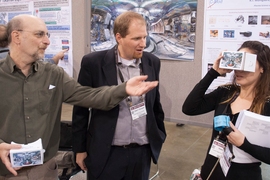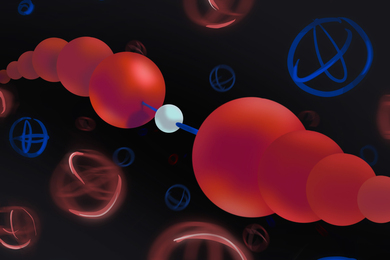On Aug. 21, Kaylee de Soto was in Tennessee viewing the eclipse — but with a newly acquired perspective on the sun’s corona, and the fusion processes going on behind the shadow of the moon.
The incoming freshman from Miami, Florida, worked this summer at the Plasma Science and Fusion Center (PSFC), where the focus is on how to recreate the sun’s fusion energy on earth. Wanting to spend her summer productively, she had explored MIT’s UROP offerings, hoping she might be eligible. Drawn to a PSFC request for someone to evaluate and explore options for the education program’s popular, but dated, video game, she took a chance and contacted the center.
“We were surprised to get a response from someone not yet registered at MIT,” PSFC research scientist Jerry Hughes says, “but were impressed with her background and her drive.”
Because de Soto was not yet officially an MIT student, the PSFC could not hire her for UROP, but offered her the project as a summer job.
The C-Mod Jr. video game, based on the MIT tokamak that completed its final run in 2016, provides a console of eight yellow buttons that control corresponding magnets spaced around a virtual cross section of a tokamak, which is typically projected onto a screen. Because the hot plasma fuel required for fusion responds to magnetic fields, participants can collectively try to control the virtual plasma by toggling their buttons on and off, pushing the plasma away from their area of the tokamak wall. The goal is to keep the plasma centered and burning, so that more fusion energy can be created.
De Soto quickly familiarized herself with C-Mod Jr., and with the current literature about digital gaming. She surveyed the graduate students and staff who currently host the game at education events, as well as teachers and students from schools that had toured the center, compiling their comments about its perceived strengths and weaknesses. She hosted the game herself for summer tour groups to see how it personally felt as a teaching tool.
“The great thing about the game is that it gets people working together to make fusion happen. Everyone has to be on the same page,” de Soto says. “But it’s somewhat limited in what it teaches.”
Based on her research, de Soto proposed five paths the PSFC could take to improve the video game and create other games, from simply updating C-Mod Jr.'s graphics and interface to creating a new digital game that would explore sustainable energy in collaboration with other MIT energy-oriented departments and laboratories. She presented her findings to the MIT community at a special seminar in early August.
“It is extraordinary for an incoming freshman to give this kind of presentation before graduate students, professors, and research scientists at the PSFC,” Hughes notes.
By the time de Soto gave her talk, she was comfortable at the PSFC, though she admits the barrage of new faces when she arrived at the center was challenging. “I was really nervous, being an incoming freshman, meeting all these adults and grad students. ‘I look really young; it’s really obvious,’ I thought. But I got to know everyone, and everyone is super nice and easygoing.”
This experience was not de Soto’s first at MIT. In 2016, she was part of MIT’s Minority Introduction to Engineering and Science (MITES) program, where she was singled out as “top student in special relativity and linear algebra courses.”
She hopes to continue working at the PSFC in the fall as a UROP student, overseeing relationships she has established with MIT’s Game Lab and MIT Energy Initiative. Both groups have expressed interest in helping to develop some of her proposals.
“We hired her to improve or replace one game, and we may end up with three,” Hughes says. “I’d say that was an excellent return on an investment.”
De Soto plans to summarize her findings as a case study, and submit it for publication to some of the gaming journals she reviewed when she began her research in July.
“When I arrived at the PSFC this summer I had no idea what nuclear science and engineering [NSE] was,” de Soto admits. “Now I may actually minor in NSE.”
While de Soto is still intent on majoring in physics, she comes to MIT with new perspective on plasma science and a passion for finding new ways to make science education fun.
PSFC education program activities are sponsored in part by the U.S. Department of Energy's Office of Fusion Energy Science.









